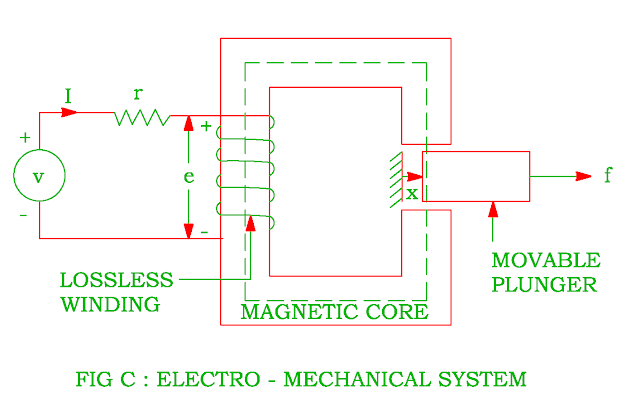The electromechanical energy conversion is done through medium of magnetic field.
It is assumed that there is no loss of energy in the magnetic field. There are two types of the excitation systems.
Singly excited system
- As its name "Singly" suggests that there is only a coil is required to produce the magnetic field.
- There is one set of electrical input terminal and one set of mechanical output terminal in this excitation system.
- The electro – magnetic relay, solenoid coil, hysteresis motor etc are the examples of singly excited system.
Analysis of singly excited system
Figure shows a force producing device in which single coil acts as an input terminal and a movable plunger serves as an output terminal. The electrical input has two variable : e ( volts ) and I (current ) whereas the mechanical output has two variables : f ( force ) and x ( distance ).
Electrical input energy
Applying Kirchhoff’s voltage Law ( KVL ) to
the input side
V = I R + e ………... (1)
As we know that
Induced emf α Rate of change of flux
linkage
e =
d /dt ( NФ )
=
N ( dФ / dt )……..(2)
From equation (1) and (2)
V = IR + N ( dФ / dt )
VI = I2R + NI ( dФ / dt )
( VI ) dt = ( I2R ) dt + NI ( dФ
)
( V – IR ) Idt = NI ( dФ )
( eI ) dt = NI ( dФ )
dWelect = ( eI ) dt = NI ( dФ )……..(3)
Energy stored in the magnetic field
- If the mechanical output energy or plunger movement is zero ( dWmech = 0 ) therefore the electrical energy input is equal to the energy stored in the magnetic field ( dWf )
dWelect = dWf ……… (4)
Mechanical output energy
- If the plunger moves distance dx in the direction of force f, the mechanical work done can be obtained as
dWmech = ( f ) dx ... ...
... (5)
- According to the energy – balance equation for electrical input
Change in stored energy = Electrical input
energy – Mechanical output energy
dWf = dWelect – dWmech
from equation (3) and (5)
dWf = N I ( dФ ) – f dx ...
... ... (6)
- It should be noted that equation (6) is used to calculate force and torque in electromechanical system.
Doubly Excited System
- As its name "Doubly" suggests that two coils are required to produce mechanical output force.
- There are two sets of electrical input terminals and one set of mechanical output terminal in this system.
- The synchronous motor, alternators, DC machines etc. are the examples of doubly excited system.
- Figure D shows an example of doubly excited field system.
- There are two windings in the rotating systems.
- One winding is wound on the stator and the other on the rotor.
- The stator and rotor windings are connected to electrical sources V1 and V2 respectively.
- The motor can allow rotating between two poles. The magnetic field depends upon the current I1 and I2 and θ between stator and rotor.
The Doubly Excited system consists of
- Three independent variable I1, I2, θ or λ1, λ2, θ
- The torque is directly proportional to the two electrical signals.
- The mechanical energy conversion does not depend upon change in current.









